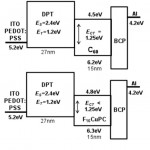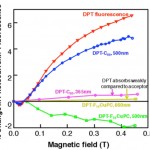Anomalous Singlet Exciton Fission Magnetic Field Effect in Diphenyltetracene-C60 Solar Cells
- Category: Energy, Optics & Photonics
- Tags: Marc Baldo, Priya Jadhav
Singlet exciton fission may find application in more efficient solar cells. Fission can reduce thermalization losses because by splitting the exciton, a high energy photon can produce two charge carrier pairs instead of one. The two device implementations to date that exploit singlet exciton fission, a pentacene photodetector and a tetracene solar cell, produce more current by multiplying the number of excitons in the visible part of the spectrum [1] [2] . In this work we show that diphenyltetracene (DPT) also exhibits singlet exciton fission; in Figure 1 we present a DPT-C60 device in which singlet exciton fission contributes negatively to the current, which is opposite behavior to the previous two implementations.
DPT differs from previous implementations of singlet exciton fission in that its triplet Et = 1.2eV [3] is less than the energy of the DPT-C60 charge transfer state (CT) ECT = 1.25eV. Hence the triplets cannot break up to form charge carriers. This effect is seen in the positive magnetic field effect shown in Figure 2. The application of a magnetic field results in reduced singlet fission and hence an increase in the number of singlet excitons and thereby increased current. In contrast, a similar measurement with a lower CT energy yields the usual negative magnetic field dependence. For example, below we demonstrate a negative magnetic field effect in DPT-F16CuPC, where F16CuPC is fluorinated copper phthalocyanine.
The amorphous nature of the DPT film in the device results in an isotropic magnetic field effect. Consequently, the large magnetic field effect shown by the device, 5% at .45T, may be used in an isotropic magnetic field detector.
- Figure 1: Device structures for the DPT-C60 and the DPT- F16CuPC devices.
- Figure 2: Magnetic field effect on photocurrent in the DPT-C60 and the DPT- F16CuPC devices. 500 nm is a DPT absorption peak. Also shown is the magnetic effect on DPT fluorescence, which is a signature of singlet fission.
- J. Lee, P. Jadhav, and M. A. Baldo, “High efficiency organic multilayer photodetectors based on singlet exciton fission,” Applied Physics Letters, vol. 95, pp. 033301-033303, July 2009 [↩]
- P. J. Jadhav, A. Mohanty, J. Sussman, and M. A. Baldo, “Singlet exciton fission in nanostructured organic solar cells,” Nano Letters, DOI: 10.1021/nl104202j. [↩]
- C. Burgdorff, T. Kircher, and H. G. Löhmannsröben, “Photophysical properties of tetracene derivatives in solution,” Spectrochimica Acta Part A: Molecular Spectroscopy vol. 44, pp. 1137-1141, Apr. 1988. [↩]

